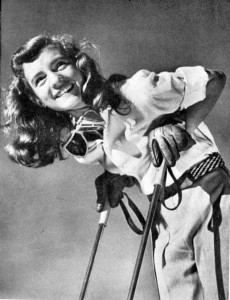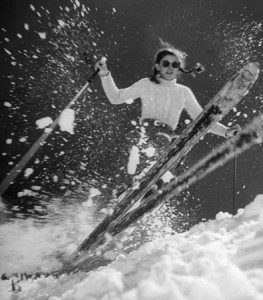Vermont is about to host an event that will add to its skiing history. The women’s World Cup circuit will visit Killington on November 26-27, that’s Thanksgiving weekend! The best women skiers in the world will be here – Lara Gut, Mikaela Shiffrin, Tessa Worley. Lindsey Vonn won’t be racing due to a broken arm she suffered training at Copper Mountain last week.
As I write this column the temperature is in the 50s, not good snowmaking weather! With literally the whole world watching, the pressure must really be on the Killington snowmaking team to have the courses ready for the races!
To emphasize the significance of this event, Vermont has only hosted one other World Cup event in the fifty year history of the FIS World Cup!
It’s very appropriate that it’s the women who will be competing here and that the race is being held at Killington. Well, actually that the race is being held in the Rutland area. The first U.S. woman skier to make a mark in international skiing competitions was from Rutland!
 Long time Stowe Host Bud Kassel remembers in 1946 when he was a teenager and his family came to Vermont for a ski trip. They went to the Pico Peak ski area which featured the first T-Bar in the United States. When Bud approached the lift for the first time, the lift attendant asked Bud if he had ever ridden a T-Bar before. Bud said no, so the lift attendant called out to a young 14 year old girl who was nearby: “Andy, show this young man how to ride the lift.”
Long time Stowe Host Bud Kassel remembers in 1946 when he was a teenager and his family came to Vermont for a ski trip. They went to the Pico Peak ski area which featured the first T-Bar in the United States. When Bud approached the lift for the first time, the lift attendant asked Bud if he had ever ridden a T-Bar before. Bud said no, so the lift attendant called out to a young 14 year old girl who was nearby: “Andy, show this young man how to ride the lift.”
“Andy” was the young Andrea Mead who would go on to be the first United States skier to win two Olympic Gold Medals in one Olympics! She was the daughter of Brad and Janet Mead who owned Pico Peak. They had Andy on skis at the age of three and racing by age ten! Her mother, Janet, was captain of the Women’s Eastern Ski Team which allowed Andy to be exposed to some of the best women ski racers in the United States. Andy would be named to the U.S. national team in 1948 at age 15!
1948 was Andrea’s first year competing against international competition. While her results at the Olympics were good for a teenager, she served notice of things to come by finishing third at the Arlberg-Kandahar event.
 1951 was a very eventful year in Andrea’s life. Racing in Europe Andrea would win 10 of the 16 races held that season. (She finished second in 4 of the others.) She also married David Lawrence, a skier on the U.S. men’s national team.
1951 was a very eventful year in Andrea’s life. Racing in Europe Andrea would win 10 of the 16 races held that season. (She finished second in 4 of the others.) She also married David Lawrence, a skier on the U.S. men’s national team.
So when the 1952 Olympics came along, newlywed Andrea Mead Lawrence was a prohibitive favorite. She would win the United States first gold medal in alpine skiing by winning the Giant Slalom. In the Slalom she fell in the first run, but got up to finish and still be in fourth place going into the second run. Andrea blitzed the field on the second run, winning her second gold by .8 seconds! She was quoted as saying, “When I took off for the second run, I was released as the full force and energy of who I am as a person!”
Andrea Mead Lawrence would mix ski racing and having a family through the 1956 Olympics. In 1955 she competed here in Stowe winning the American International races in both GS and Slalom. Between then and the 1956 Olympics she would have the third of the Lawrences’ five children. While she didn’t win any medals at those Olympics, she did finish fourth just out of the medals in GS.
“You can only be a world class athlete so many years, it is what you do with the rest of your life that counts.”
 Starting in the 1960s, Andrea Mead Lawrence would apply her talents to an entirely different field. Living in Mammoth Lakes, California, she became involved in preserving the eastern Sierra from rampant development. She became a national voice for balancing development with environmental concerns. In 2003 she founded the Andrea Lawrence Institute for Mountains and Rivers.
Starting in the 1960s, Andrea Mead Lawrence would apply her talents to an entirely different field. Living in Mammoth Lakes, California, she became involved in preserving the eastern Sierra from rampant development. She became a national voice for balancing development with environmental concerns. In 2003 she founded the Andrea Lawrence Institute for Mountains and Rivers.
Andrea Mead Lawrence passed away in 2009. There’s a 12,000 foot peak named in her memory in the eastern Sierra, very fitting for a world-class skier and environmentalist.

Leave a Reply